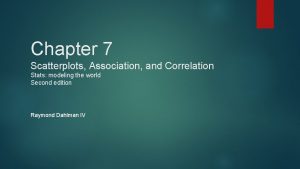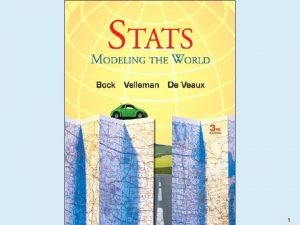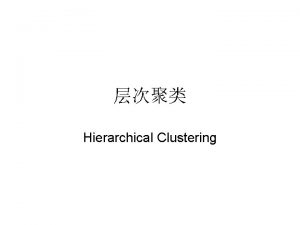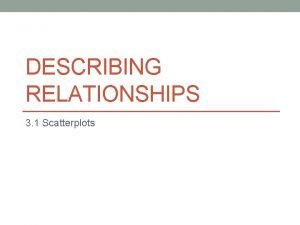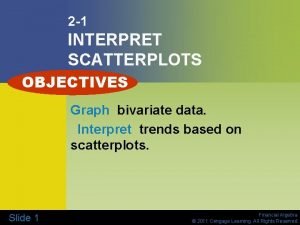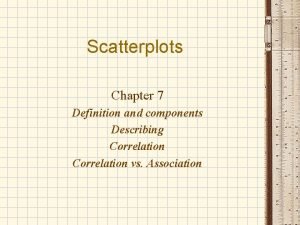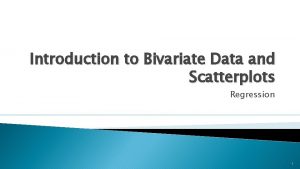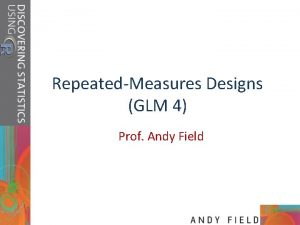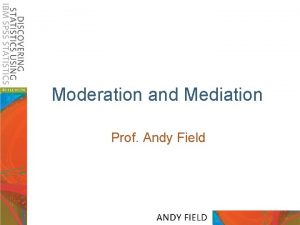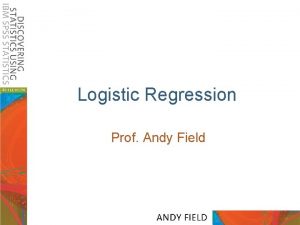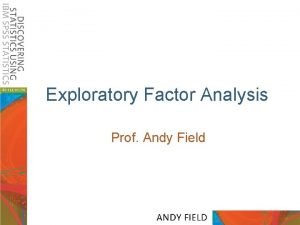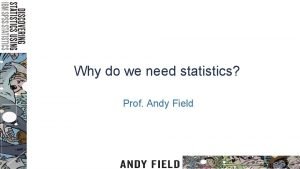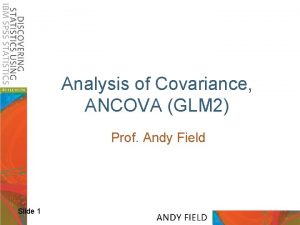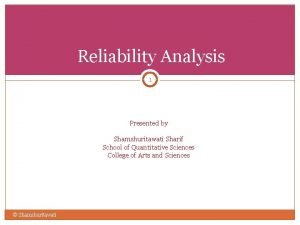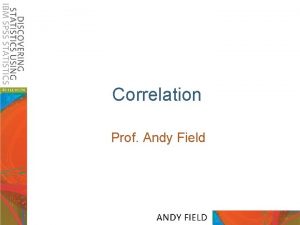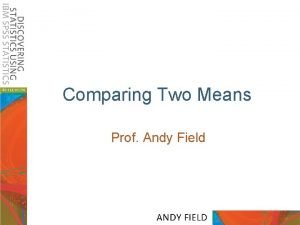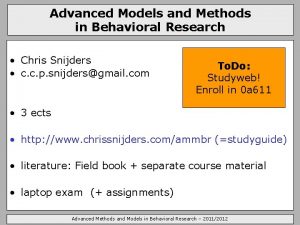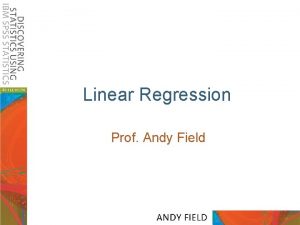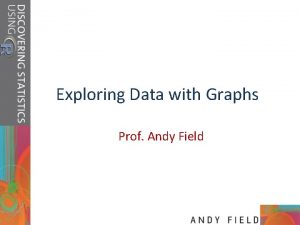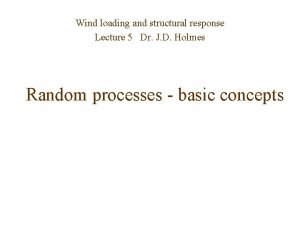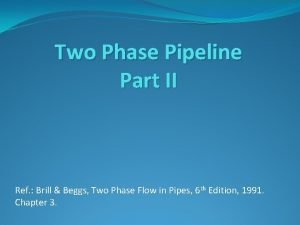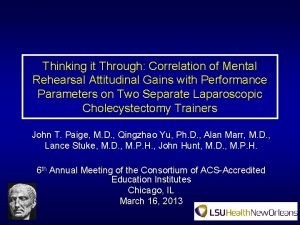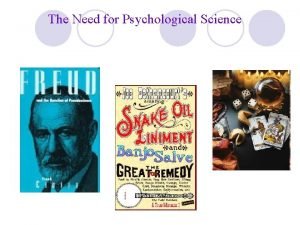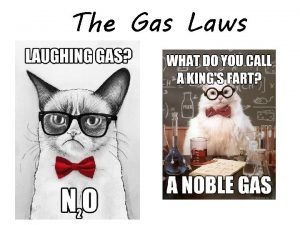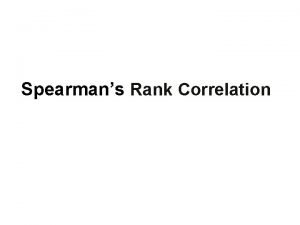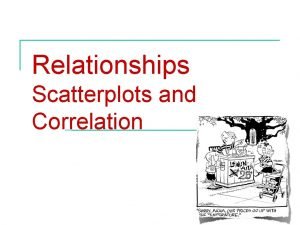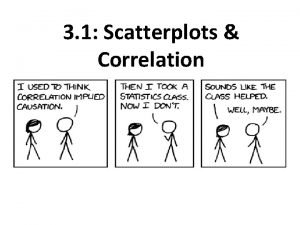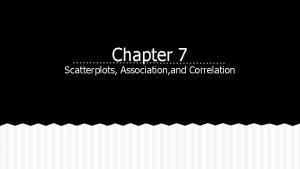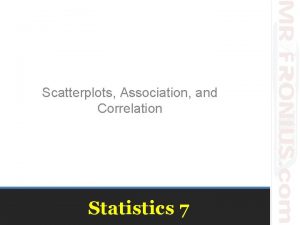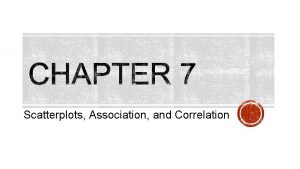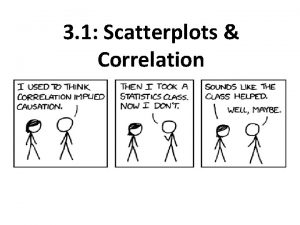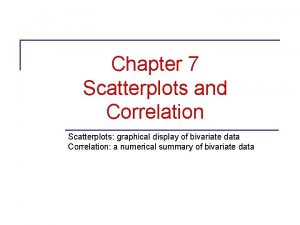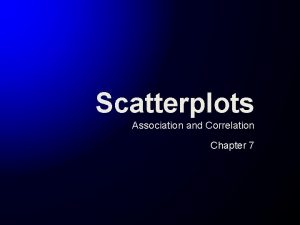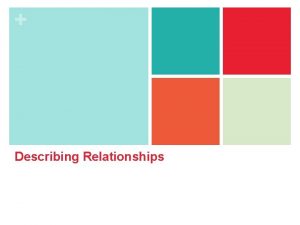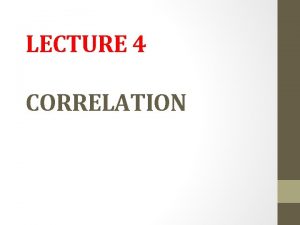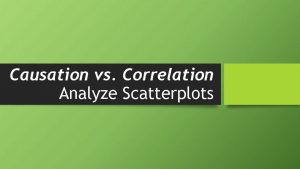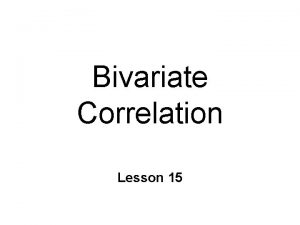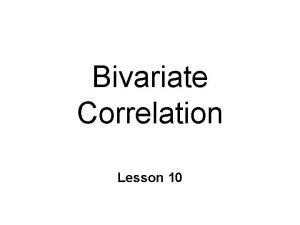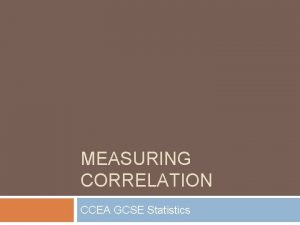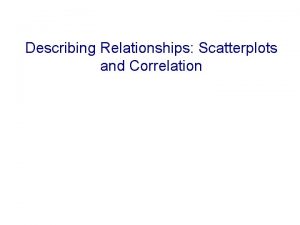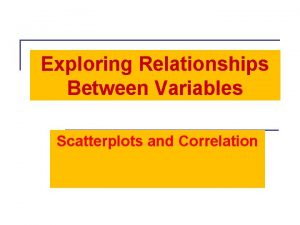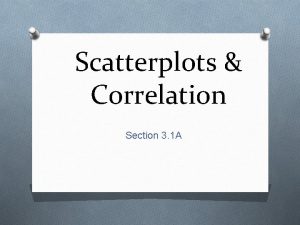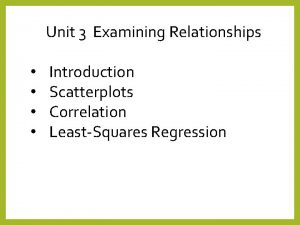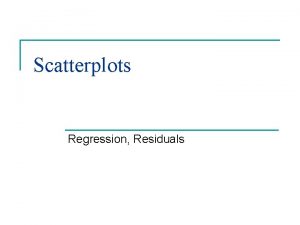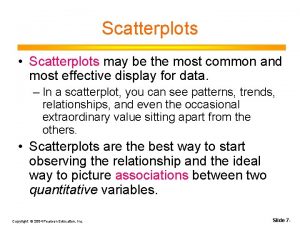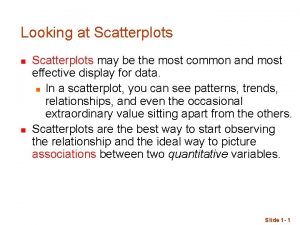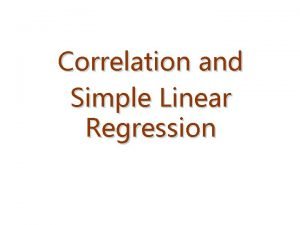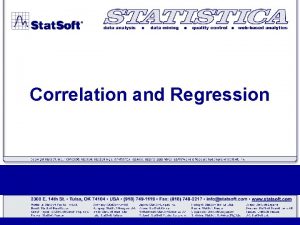Correlation Prof Andy Field Aims Measuring Relationships Scatterplots





































- Slides: 37

Correlation Prof. Andy Field

Aims • Measuring Relationships – Scatterplots – Covariance – Pearson’s Correlation Coefficient • Nonparametric measures – Spearman’s Rho – Kendall’s Tau • Interpreting Correlations – Causality • Partial Correlations

What is a Correlation? • It is a way of measuring the extent to which two variables are related. • It measures the pattern of responses across variables.

Slide

Slide

Slide

Measuring Relationships • We need to see whether as one variable increases, the other increases, decreases or stays the same. • This can be done by calculating the Covariance. – We look at how much each score deviates from the mean. – If both variables deviate from the mean by the same amount, they are likely to be related.

Modeling Relationships • First, look at some scatterplots of the variables that have been measured. • Outcomei = (model ) + errori • Outcomei = (b. Xi ) + errori



Revision of Variance • The variance tells us by how much scores deviate from the mean for a single variable. • It is closely linked to the sum of squares. • Covariance is similar – it tells is by how much scores on two variables differ from their respective means.


Covariance • Calculate the error between the mean and each subject’s score for the first variable (x). • Calculate the error between the mean and their score for the second variable (y). • Multiply these error values. • Add these values and you get the cross product deviations. • The covariance is the average crossproduct deviations:



Problems with Covariance • It depends upon the units of measurement. – E. g. The Covariance of two variables measured in Miles might be 4. 25, but if the same scores are converted to Km, the Covariance is 11. • One solution: standardise it! – Divide by the standard deviations of both variables. • The standardised version of Covariance is known as the Correlation coefficient. – It is relatively unaffected by units of measurement.

The Correlation Coefficient

The Correlation Coefficient

Correlation: Example • Anxiety and Exam Performance • Participants: – 103 students • Measures – Time spent revising (hours) – Exam performance (%) – Exam Anxiety (the EAQ, score out of 100)

Conducting Correlation Analysis

Doing a Correlation

Bootstrap-sample correlation Bootstrap Sample 1 -0. 50 Sample Bootstrap Sample 2 Bootstrap Sample N -0. 72 … … -0. 81 95% of bootstrap samples

Correlation Output

Reporting the Results

Things to know about the Correlation • It varies between -1 and +1 – 0 = no relationship • It is an effect size – ±. 1 = small effect – ±. 3 = medium effect – ±. 5 = large effect • Coefficient of determination, r 2 – By squaring the value of r you get the proportion of variance in one variable shared by the other.

Experimental Research Methods • Cause and Effect (Hume, 1748) 1. 2. 3. Cause and effect must occur close together in time (contiguity); The cause must occur before an effect does; The effect should never occur without the presence of the cause. • Confounding variables: the ‘Tertium Quid’ – A variable (that we may or may not have measured) other than the predictor variables that potentially affects an outcome variable. – E. g. The relationship between breast implants and suicide is confounded by self-esteem. • Ruling out confounds (Mill, 1865) – An effect should be present when the cause is present and when the cause is absent the effect should be absent also. – Control conditions: the cause is absent.

Correlation and Causality • The third-variable problem: – in any correlation, causality between two variables cannot be assumed because there may be other measured or unmeasured variables affecting the results. • Direction of causality: – Correlation coefficients say nothing about which variable causes the other to change

Nonparametric Correlation • Spearman’s Rho – Pearson’s correlation on the ranked data • Kendall’s Tau – Better than Spearman’s for small samples • World’s best Liar Competition – 68 contestants – Measures • Where they were placed in the competition (first, second, third, etc. ) • Creativity questionnaire (maximum score 60)

Correlation Output Spearman’s rho

Correlation Output Kendall’s tau

(Point-)biserial correlation • Point-biserial correlation, rpb: relationship between – a continuous variable and – a variable that is a discrete dichotomy (no underlying continuum) • Biserial correlation, rb: relationship between – a continuous variable and – a variable that is a continuous dichotomy (continuum underlying the two categories)

Partial and Semi-Partial Correlations • Partial correlation: – Measures the relationship between two variables, controlling for the effect that a third variable has on them both. • Semi-partial correlation: – Measures the relationship between two variables controlling for the effect that a third variable has on only one of the others. Slide


Andy Field

Doing Partial Correlation

Partial Correlation Output

Conclusion • • Scattergram Covariance Pearson’s correlation Bootstrapping for significance testing and confidence intervals • Correlation and causation • Non-parametric correlation • Partial correlation Slide
 Chapter 7 scatterplots association and correlation
Chapter 7 scatterplots association and correlation Chapter 7 scatterplots association and correlation
Chapter 7 scatterplots association and correlation Positive correlation versus negative correlation
Positive correlation versus negative correlation Positive and negative correlation
Positive and negative correlation Measuring cluster validity via correlation
Measuring cluster validity via correlation Describing scatterplots
Describing scatterplots 2-1 interpret scatterplots
2-1 interpret scatterplots Association vs correlation
Association vs correlation Introduction to bivariate data
Introduction to bivariate data Andy field repeated measures anova
Andy field repeated measures anova Baron and kenny (1986)
Baron and kenny (1986) Andy field multiple regression
Andy field multiple regression Andy field factor analysis
Andy field factor analysis Andy field decision tree
Andy field decision tree Advantages of ancova
Advantages of ancova Shamshuritawati sharif
Shamshuritawati sharif Andy field
Andy field Andy field
Andy field Andy field
Andy field Andy field
Andy field Andy field
Andy field Electric field and magnetic field difference
Electric field and magnetic field difference Individual differences in second language learning
Individual differences in second language learning Field dependent vs field independent
Field dependent vs field independent Q factor of capacitor
Q factor of capacitor E field h field
E field h field Data types and field properties
Data types and field properties Field dependent and field independent
Field dependent and field independent Magnetic field
Magnetic field Load response correlation
Load response correlation Tabel rank spearman lengkap
Tabel rank spearman lengkap Beggs and brill pressure drop calculation
Beggs and brill pressure drop calculation Limitations of mental rehearsal
Limitations of mental rehearsal Eq and iq correlation
Eq and iq correlation Examples of naturalistic observation
Examples of naturalistic observation Is volume vs pressure direct or indirect
Is volume vs pressure direct or indirect Reading correlation chart
Reading correlation chart Difference between spearman and pearson correlation
Difference between spearman and pearson correlation
